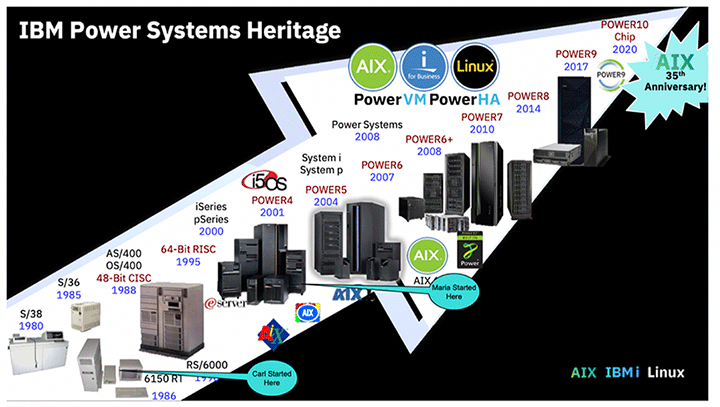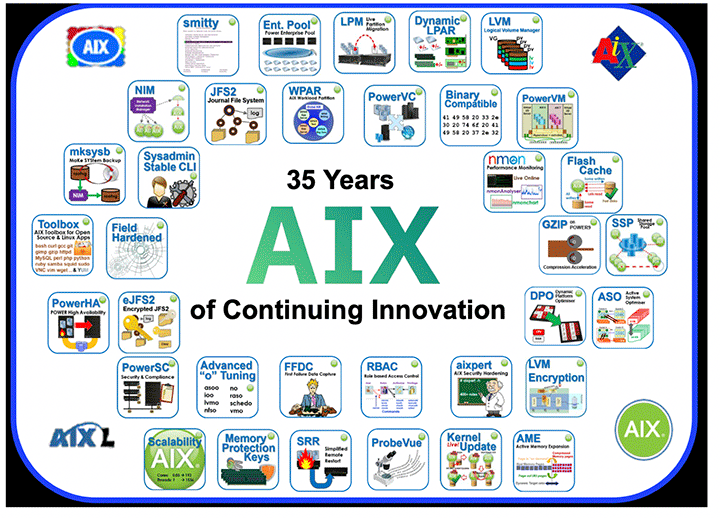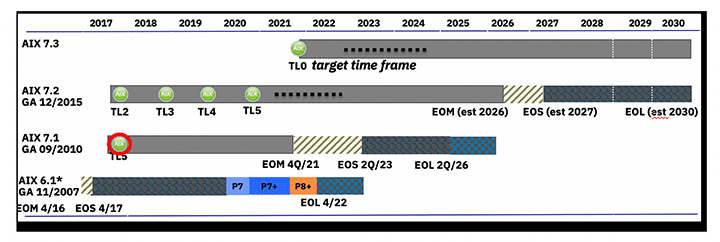Ron Gordon
Director » Power Systems
In 2021 IBM will be celebrating the 35th anniversary of the AIX operating system which was originally developed for the IBM RISC workstation, but for the last many years has mainly been successfully supported on Power System. The Advanced Interactive eXecutive (AIX) operating system has gone through many changes in the past 35 years keeping up with POWER technology support and implementing new function and usability for industry needs and customer requests. Today’s Power Systems community is comprised of many people that are proud of being part of AIX’s success and leadership journey. This chart depicts that journey along with some key Power Systems changes:


AIX 7.2.5
The current 7.2.5 release of AIX demonstrates the commitment presented in the 2019 IBM AIX Executive Strategy paper. The paper, IBM AIX – An executive guide to the strategy and roadmap for the AIX Operating System for IBM Power Systems, was written in response to concerns of many AIX customers on the heels of IBM’s acquisition of Red Hat, the focus on Open Source, AI, and Cloud solutions, all of which are primarily Linux-based. See my blog for more information on the topic.
The new functionality in AIX 7.2.5 illustrates IBM’s commitment of addressing the latest security concerns, scalability and performance, inclusion and exploitation of Open Source, and continuous computing.
- Security: AIX 7.2.5 now supports logical volume encryption, new IPSEC performance and features, and SMB 3.0.2 file sharing with Windows x86 systems.
- Performance and Scaling: The new enhanced multi-queue NPIV performance in conjunction with VIOS 3.1.2 is showing up to 87% increase in IOPs of high demand workloads. Also, AIX 7.2.5 has implemented FC-NVMe for AIX Physical I/O, enhanced virtual storage r/w timeout controls, support for 14 million open JFS2 files per SRAD, and for better capacity management of storage, NVMe drive space reclamation.
- Open Source: AIX is providing Red Hat Ansible playbooks to control many functions in both AIX, VIOS, and HMC operations. These playbooks are distributed with AIX 7.2.5 and are also in the Red Hat Automation Hub and Galaxy (https://galaxy.ansible.com/ibm/power_aix).
- Continuous Computing: AIX Live Updates include support for IBM Spectrum Protect w/ NPIV tape, certified support of Oracle ASM on raw AIX LVs, Veritas InfoScale compatibility, and certification of SAP ECC best practices documented in SAP note 2977742.
POWER10 and AIX 7.3
POWER10 technology was announced in August 2020 and the systems are expected to be available starting late 2021. IBM released a Statement of Direction for AIX 7.3 to be made generally available later in 2021, to fully support POWER10 systems in native mode. I suspect there will be continued evolution of continuous operations, Open Source inclusion, capacity and scaling, and security.
But what if you cannot move to AIX 7.3 that fast?
IBM has announced several support options:
- AIX 7.1 will support POWER10 in POWER8 mode with VIOS;
- AIX 7.2 will support POWER10 in POWER8 or POWER9 mode with VIOS and physical I/O;
- AIX 7.3 will fully support POWER10, POWER9, and POWER8 systems;
- NOTE: there is no plan for AIX 6.1 on POWER10.
For your planning purposes, here is an illustration depicting the AIX roadmap:

IBM Power Systems AIX Enterprise Cloud Edition bundle
In today’s IT world, cloud computing is being utilized (or at least being considered) to achieve flexibility, scalability, and cost savings. Use cases include long term storage, backup, disaster recovery, Dev/Test, incremental capacity, etc. Hybrid Cloud is currently being viewed as the technology to allow “seamless” integration to data and apps that must remain on premises for performance, compliance, and security requirements but to utilize the Cloud for the extended value it can provide.
The integration architecture is dependent on connectivity, performance, IaaS, PaaS, SaaS, customer needs, and choices. The many components needed to enable the integrated architecture of Hybrid Cloud are available from software ISVs, Cloud providers, and storage providers, while selecting the compatible options and making them work together is a complex task.
When looking at Hybrid Cloud solutions where AIX is the primary operating system, you should consider the IBM Power Systems AIX Enterprise Cloud Edition bundle. This bundle is similar to the AIX Enterprise Edition bundle you may be using but it contains software that supports Hybrid Cloud implementation and operations. The IBM Power Systems AIX Enterprise Cloud Edition bundle contains:
- PowerVC for Private Cloud
- CMC
- Tivoli Monitoring
- PowerSC and PowerSC MFA
- VMR DR
- Aspera
The bundle provides a 64% cost saving over individual product purchases. The IBM feature code is 5765-ECB or 5765-CBA, the latter including AIX.
More Information
Keeping up with these changes and understanding implementation can be a daunting task. Usually, IBM Redbooks are great sources, but they are not always current. The IBM Power Systems Community is a collaborative site offering updated content, blogs, and forums. It is free of charge, open to everyone, and has a wealth of deep information on all topics relative to Power Systems from Hybrid Cloud, to PowerVM, to PowerHA and also AIX and Linux for Power Systems.
For additional information and planning assistance, please contact your Mainline Account Executive directly or contact us.
Related Articles
BLOG: Is AIX Dead? IBM Publishes AIX Strategy and Roadmap Document
BLOG: IBM Power Systems February 2021 Hardware Announcements

